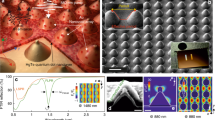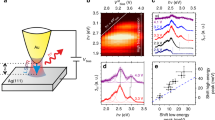Abstract
Few inventions have shaped the world like the incandescent bulb. Edison used thermal radiation from ohmically heated conductors, but some noble metals also exhibit ‘cold’ electroluminescence in percolation films1,2, tunnel diodes3, electromigrated nanoparticle aggregates4,5, optical antennas6 or scanning tunnelling microscopy7,8,9. The origin of this radiation, which is spectrally broad and depends on applied bias, is controversial given the low radiative yields of electronic transitions. Nanoparticle electroluminescence is particularly intriguing because it involves localized surface-plasmon resonances with large dipole moments. Such plasmons enable very efficient non-radiative fluorescence resonance energy transfer (FRET) coupling to proximal resonant dipole transitions. Here, we demonstrate nanoscopic FRET–light-emitting diodes which exploit the opposite process, energy transfer from silver nanoparticles to exfoliated monolayers of transition-metal dichalcogenides10. In diffraction-limited hotspots showing pronounced photon bunching, broadband silver electroluminescence is focused into the narrow excitonic resonance of the atomically thin overlayer. Such devices may offer alternatives to conventional nano-light-emitting diodes11 in on-chip optical interconnects.
This is a preview of subscription content, access via your institution
Access options
Access Nature and 54 other Nature Portfolio journals
Get Nature+, our best-value online-access subscription
$29.99 / 30 days
cancel any time
Subscribe to this journal
Receive 12 print issues and online access
$259.00 per year
only $21.58 per issue
Buy this article
- Purchase on Springer Link
- Instant access to full article PDF
Prices may be subject to local taxes which are calculated during checkout




Similar content being viewed by others
References
Nepijko, S. A. et al. Light emission from Ag cluster films excited by conduction current. Ann. Phys. 9, 125–131 (2000).
Borzjak, P. G. et al. Neue Erscheinungen in sehr dünnen Metallschichten. Phys. Stat. Sol. 8, 55–58 (1965).
Lambe, J. et al. Light-emission from inelastic electron-tunneling. Phys. Rev. Lett. 37, 923 (1976).
Gonzalez, J. I. et al. Quantum mechanical single-gold-nanocluster electroluminescent light source at room temperature. Phys. Rev. Lett. 93, 147402 (2004).
Lee, T. H. et al. Single-molecule optoelectronics. Acc. Chem. Res. 38, 534–541 (2005).
Kern, J. et al. Electrically driven optical antennas. Nat. Photon. 9, 582–586 (2015).
Nilius, N. et al. Photon emission spectroscopy of individual oxide-supported silver clusters in a scanning tunneling microscope. Phys. Rev. Lett. 84, 3994 (2000).
Berndt, R. et al. Inelastic tunneling excitation of tip-induced plasmon modes on noble-metal surfaces. Phys. Rev. Lett. 67, 3796–3799 (1991).
Chen, C. et al. Visualization of Fermi's golden rule through imaging of light emission from atomic silver chains. Science 325, 981–985 (2009).
Mak, K. F. et al. Atomically thin MoS2: a new direct-gap semiconductor. Phys. Rev. Lett. 105, 136805 (2010).
Mueller, T. et al. Efficient narrow-band light emission from a single carbon nanotube p–n diode. Nat. Nanotech. 5, 27–31 (2010).
Klein, D. L. et al. A single-electron transistor made from a cadmium selenide nanocrystal. Nature 389, 699–701 (1997).
Schneider, N. L. et al. Optical probe of quantum shot-noise reduction at a single-atom contact. Phys. Rev. Lett. 105, 026601 (2010).
Coe, S. et al. Electroluminescence from single monolayers of nanocrystals in molecular organic devices. Nature 420, 800–803 (2002).
Achermann, M. et al. Energy-transfer pumping of semiconductor nanocrystals using an epitaxial quantum well. Nature 429, 642–646 (2004).
Castellanos-Gomez, A. et al. Deterministic transfer of two-dimensional materials by all-dry viscoelastic stamping. 2D Mater. 1, 011002 (2014).
Baugher, B. W. H. et al. Optoelectronic devices based on electrically tunable p–n diodes in a monolayer dichalcogenide. Nat. Nanotech. 9, 262–267 (2014).
Ross, J. S. et al. Electrically tunable excitonic light-emitting diodes based on monolayer WSe2 p–n junctions. Nat. Nanotech. 9, 268–272 (2014).
Sundaram, R. S. et al. Electroluminescence in single layer MoS2 . Nano Lett. 13, 1416–1421 (2013).
Silly, F. et al. Time-autocorrelation in scanning-tunneling-microscope-induced photon emission from metallic surface. Appl. Phys. Lett. 77, 3648 (2000).
Barnes, W. L. Fluorescence near interfaces: the role of photonic mode density. J. Mod. Opt. 45, 661–699 (1998).
Chizhik, A. I. et al. Metal-induced energy transfer for live cell nanoscopy. Nat. Photon. 8, 124–127 (2014).
Drexhage, K. H. Influence of a dielectric interface on fluorescence decay time. J. Lumin. 1, 693–701 (1970).
Swathi, R. S. et al. Long range resonance energy transfer from a dye molecule to graphene has (distance)(−4) dependence. J. Chem. Phys. 130, 086101 (2009).
Prins, F. et al. Reduced dielectric screening and enhanced energy transfer in single- and few-layer MoS2 . Nano Lett. 14, 6087–6091 (2014).
Raja, A. et al. Energy transfer from quantum dots to graphene and MoS2: the role of absorption and screening in two-dimensional materials. Nano Lett. 16, 2328–2333 (2016).
Poellmann, C. et al. Resonant internal quantum transitions and femtosecond radiative decay of excitons in monolayer WSe2 . Nat. Mater. 14, 889–893 (2015).
Chernikov, A. et al. Exciton binding energy and nonhydrogenic Rydberg series in monolayer WS2 . Phys. Rev. Lett. 113, 076802 (2014).
Li, Y. et al. Measurement of the optical dielectric function of monolayer transition-metal dichalcogenides: MoS2, MoSe2, WS2, and WSe2 . Phys. Rev. B 90, 205422 (2014).
Plechinger, G. et al. Control of biaxial strain in single-layer molybdenite using local thermal expansion of the substrate. 2D Mater. 2, 015006 (2015).
Chaudhuri, D. et al. Toward subdiffraction transmission microscopy of diffuse materials with silver nanoparticle white-light beacons. Nano Lett. 9, 952–956 (2009).
Bao, W. et al. Visualizing nanoscale excitonic relaxation properties of disordered edges and grain boundaries in monolayer molybdenum disulfide. Nat. Commun. 6, 7993 (2015).
Acknowledgements
The authors thank E. Mishchenko for stimulating discussions and R. Martin for assistance with sample fabrication. This work was inspired by a Scialog Fellowship (J.M.L.) of the Research Corporation for Science Advancement. The authors acknowledge the DFG for providing collaborative funding (SFB 689 and GRK 1570). J.M.L. acknowledges financial support from the European Research Council through Starting Grant MolMesON (no. 305020). A.C. acknowledges funding from the DFG through the Emmy Noether Programme (CH 1672/1-1).
Author information
Authors and Affiliations
Contributions
R.P.P., F.S., G.P., F.H., I.C., J.K., P.N. and J.V. performed the experiments and analysed the data. A.C., T.K. and C.S. contributed materials and analysis tools. J.M.L. and S.B. conceived and designed the experiments. J.M.L. wrote the paper with input from the authors.
Corresponding author
Ethics declarations
Competing interests
The authors declare no competing financial interests.
Rights and permissions
About this article
Cite this article
Puchert, R., Steiner, F., Plechinger, G. et al. Spectral focusing of broadband silver electroluminescence in nanoscopic FRET-LEDs. Nature Nanotech 12, 637–641 (2017). https://doi.org/10.1038/nnano.2017.48
Received:
Accepted:
Published:
Issue Date:
DOI: https://doi.org/10.1038/nnano.2017.48
This article is cited by
-
Exciton-assisted electron tunnelling in van der Waals heterostructures
Nature Materials (2023)
-
Light emission from the layered metal 2H-TaSe2 and its potential applications
Communications Physics (2019)



